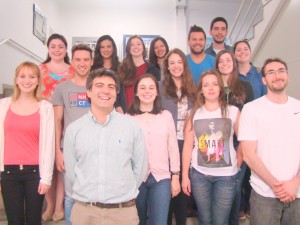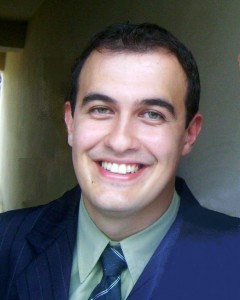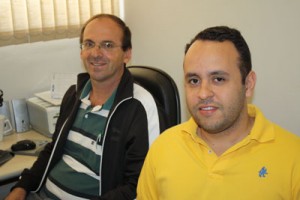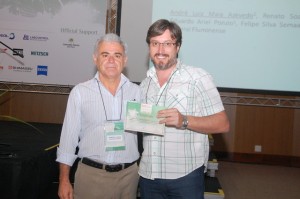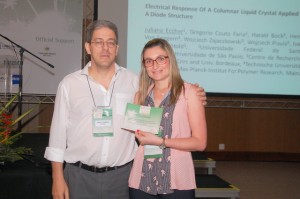The Bernhard Gross Award, granted by the Brazilian MRS (SBPMat) highlights the best works in each symposium of the annual SBPMat meetings (an oral work and a poster per symposium, at most), presented by undergraduate or graduate students. Among the finalists, the best oral work and the best poster of all the meeting are chosen each year. (Know more about Bernhard Gross, one of the pioneers of research on materials in Brazil).
At the closing ceremony of XIII Meeting of SBPMat, in the morning of the 2nd of October 2014, at the Convention Center of João Pessoa (PB), the winners of the 2014 Bernhard Gross Award were announced and award certificates were handed in. The awarded papers this year may be part of a special edition in the open access magazine “IOP Conference Series: Materials Science and Engineering”.
Here is the list of the works distinguished with the 2014 Bernhard Gross Award.
2014 winners
Oral: Electrical Response Of A Columnar Liquid Crystal Applied In A Diode Structure. Juliana Eccher1, Gregorio Couto Faria2, Harald Bock3, Heinz Von Seggern4, Wojciech Zajaczkowski5, Wojciech Pisula5, Ivan H. Bechtold1; 1Universidade Federal de Santa Catarina, 2Universidade de São Paulo, 3Centre de Recherche Paul Pascal, Cnrs and Univ. Bordeaux, 4Technische Universität Darmstadt, 5Max-Planck-Institut For Polymer Research, Mainz
Poster: Sensor Development Exploiting Graphite-Epoxy Composite As Electrode Material. André Luiz Maia Azevedo1, Renato Soares de Oliveira1, Eduardo Ariel Ponzio1, Felipe Silva Semaan1; 1Universidade Federal Fluminense
– Simposium A winners
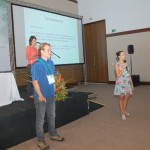 Poster: Information On Crystallinity Index Of Sugarcane Biomass Submitted To A Chemical and Enzymatic Treatment Via Solid-State Nuclear Magnetic Resonance (Ssnmr); Oigres Daniel Bernardinelli1, Igor Polikarpov1, Eduardo Ribeiro de Azevedo1; 1Instituto de Física de Sao Carlos.
Poster: Information On Crystallinity Index Of Sugarcane Biomass Submitted To A Chemical and Enzymatic Treatment Via Solid-State Nuclear Magnetic Resonance (Ssnmr); Oigres Daniel Bernardinelli1, Igor Polikarpov1, Eduardo Ribeiro de Azevedo1; 1Instituto de Física de Sao Carlos.
– Simposium B winners
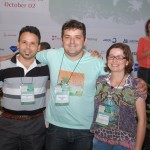 Oral: Synthesis Of Potassium Niobates By Microwave Assisted Solvothermal Method; Thiago Marinho Duarte1, Luzia Maria Castro Honório1, Juliana Kelly Dionízio de Souza1, Arnayra Sonayra Brito Silva1, Elson Longo2, Ricardo Luis Tranquilin3, Iêda Maria Garcia Santos4, Antônio Gouveia de Souza1, Ary da Silva Maia1; 1Universidade Federal da Paraiba, 2Universidade Estadual Paulista, Campus de Araraquara, 3Universidade Federal de São Carlos – Campus: São Carlos,4Universidade Federal da Paraíba.
Oral: Synthesis Of Potassium Niobates By Microwave Assisted Solvothermal Method; Thiago Marinho Duarte1, Luzia Maria Castro Honório1, Juliana Kelly Dionízio de Souza1, Arnayra Sonayra Brito Silva1, Elson Longo2, Ricardo Luis Tranquilin3, Iêda Maria Garcia Santos4, Antônio Gouveia de Souza1, Ary da Silva Maia1; 1Universidade Federal da Paraiba, 2Universidade Estadual Paulista, Campus de Araraquara, 3Universidade Federal de São Carlos – Campus: São Carlos,4Universidade Federal da Paraíba.
– Simposium C winners
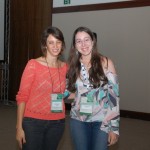 Poster: Magnetic Particles As Affinity Matrix For Purification Of Antithrombin; Aurenice Arruda Dutra Das Merces1, Jackeline da Costa Maciel2, Luiz Bezerra de Carvalho Júnior1; 1Universidade Federal de Pernambuco, 2Universidade Federal de Roraima.
Poster: Magnetic Particles As Affinity Matrix For Purification Of Antithrombin; Aurenice Arruda Dutra Das Merces1, Jackeline da Costa Maciel2, Luiz Bezerra de Carvalho Júnior1; 1Universidade Federal de Pernambuco, 2Universidade Federal de Roraima.
– Simposium D winners
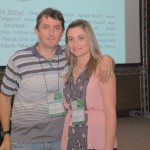 Oral: Electrical Response Of A Columnar Liquid Crystal Applied In A Diode Structure. Juliana Eccher1, Gregorio Couto Faria2, Harald Bock3, Heinz Von Seggern4, Wojciech Zajaczkowski5, Wojciech Pisula5, Ivan H. Bechtold1; 1Universidade Federal de Santa Catarina, 2Universidade de São Paulo, 3Centre de Recherche Paul Pascal, Cnrs and Univ. Bordeaux, 4Technische Universität Darmstadt, 5Max-Planck-Institut For Polymer Research, Mainz.
Oral: Electrical Response Of A Columnar Liquid Crystal Applied In A Diode Structure. Juliana Eccher1, Gregorio Couto Faria2, Harald Bock3, Heinz Von Seggern4, Wojciech Zajaczkowski5, Wojciech Pisula5, Ivan H. Bechtold1; 1Universidade Federal de Santa Catarina, 2Universidade de São Paulo, 3Centre de Recherche Paul Pascal, Cnrs and Univ. Bordeaux, 4Technische Universität Darmstadt, 5Max-Planck-Institut For Polymer Research, Mainz.
 Poster: How Surface Interactions Freeze Polymer Molecules At Room Temperature: A Single Molecule Approach; Francineide Lopes de Araújo1, Gustavo Targino Valente1, Roberto Mendonça Faria1, Francisco Eduardo Gontijo Guimarães1; 1São Carlos Institute Of Physics, University Of São Paulo.
Poster: How Surface Interactions Freeze Polymer Molecules At Room Temperature: A Single Molecule Approach; Francineide Lopes de Araújo1, Gustavo Targino Valente1, Roberto Mendonça Faria1, Francisco Eduardo Gontijo Guimarães1; 1São Carlos Institute Of Physics, University Of São Paulo.
– Simposia E/G/P winners
 Oral: Bioactive Hybrid Aminopropyl-Silica Coating To Support Neuronal Growth and Suppress Astrocyte Development; Larissa Brentano Capeletti1,2,3, Mateus B. Cardoso2, João Henrique Zimnoch dos Santos4, Wei He1; 1University Of Tennessee Knoxville, 2Laboratório Nacional de Luz Síncrotron, 3Universidade do Rio Grande do Sul, 4Universidade Federal do Rio Grande do Sul.
Oral: Bioactive Hybrid Aminopropyl-Silica Coating To Support Neuronal Growth and Suppress Astrocyte Development; Larissa Brentano Capeletti1,2,3, Mateus B. Cardoso2, João Henrique Zimnoch dos Santos4, Wei He1; 1University Of Tennessee Knoxville, 2Laboratório Nacional de Luz Síncrotron, 3Universidade do Rio Grande do Sul, 4Universidade Federal do Rio Grande do Sul.
– Simposium F winners
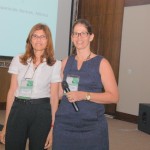 Oral: Evaluation of polymeric coatings on their efficiency of inhibiting the formation of inorganic scale. Maria de Fátima B. Souza, Celso Aparecido Bertran, Mônica de Oliveira Penna.
Oral: Evaluation of polymeric coatings on their efficiency of inhibiting the formation of inorganic scale. Maria de Fátima B. Souza, Celso Aparecido Bertran, Mônica de Oliveira Penna.
– Simposium G winners
 Poster: Theoretical Investigation Of Optical and Structural Properties Of Ba-Doped Zno Material; Luis Henrique da Silveira Lacerda1, Sergio Ricardo de Lazaro1, Renan Augusto Ribeiro1; 1Universidade Estadual de Ponta Grossa.
Poster: Theoretical Investigation Of Optical and Structural Properties Of Ba-Doped Zno Material; Luis Henrique da Silveira Lacerda1, Sergio Ricardo de Lazaro1, Renan Augusto Ribeiro1; 1Universidade Estadual de Ponta Grossa.
– Simposium H winners
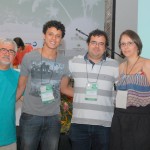 Oral: Luminescence Mechanism Of Titanium Doped Rare Earth Oxysulfides Phosphors Obtained By Rapid Microwave Preparation; José Miranda Carvalho1, Cássio Cardoso Santos Pedroso1, Miguel Aguirre Stock Grein Barbará1, Pawel Gluchowski2,3, Lucas Carvalho Veloso Rodrigues4, Maria Cláudia França da Cunha Felinto5, Jorma Hölsä2, Hermi Felinto Brito4; 1Instituto de Química da Usp, 2University Of Turku / Turun Yliopisto, 3Institute Of Low Temperature and Structure Research, 4Universidade de São Paulo, 5Instituto de Pesquisas Energéticas e Nucleares.
Oral: Luminescence Mechanism Of Titanium Doped Rare Earth Oxysulfides Phosphors Obtained By Rapid Microwave Preparation; José Miranda Carvalho1, Cássio Cardoso Santos Pedroso1, Miguel Aguirre Stock Grein Barbará1, Pawel Gluchowski2,3, Lucas Carvalho Veloso Rodrigues4, Maria Cláudia França da Cunha Felinto5, Jorma Hölsä2, Hermi Felinto Brito4; 1Instituto de Química da Usp, 2University Of Turku / Turun Yliopisto, 3Institute Of Low Temperature and Structure Research, 4Universidade de São Paulo, 5Instituto de Pesquisas Energéticas e Nucleares.
Poster: Amino Funcionalization Of Y2O3:eu(Iii) Red Nanophosphor Monitored By Luminescence Spectroscopy and Transmission Electron Microscopy; André Lucas Costa1, João Paulo Gelamos1, Gabriel Mamoru Marques Shinohara2, Sergio Antonio Marques Lima1, Ana Maria Pires1; 1Fct-Unesp Campus de Presidente Prudente, 2Instituto de Química da Unesp.
– Simposium K winners
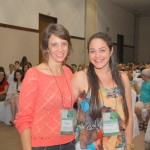 Oral: Automatic Reconstruction Of Austenite Grain Structure In Martensitic Eurofer-97 Steel From Electron Backscatter Diffraction Data; Verona Biancardi Oliveira1, Hugo Ricardo Zschommler Sandim1; 1Escola de Engenharia de Lorena – Universidade de São Paulo.
Oral: Automatic Reconstruction Of Austenite Grain Structure In Martensitic Eurofer-97 Steel From Electron Backscatter Diffraction Data; Verona Biancardi Oliveira1, Hugo Ricardo Zschommler Sandim1; 1Escola de Engenharia de Lorena – Universidade de São Paulo.
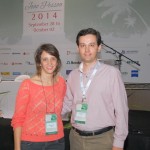 Poster: A Dilatometric Study Of The Continuous Heating Transformations In Maraging 300 Steel; Adriano Gonçalves dos Reis1, Danieli Aparecida Pereira Reis2, Antonio Jorge Abdalla3, Jorge Otubo1, Hugo Ricardo Zschommler Sandim4; 1Instituto Tecnológico de Aeronáutica, 2Universidade Federal de São Paulo, 3Instituto de Estudos Avançados, 4Escola de Engenharia Química de Lorena – Universidade de São Paulo.
Poster: A Dilatometric Study Of The Continuous Heating Transformations In Maraging 300 Steel; Adriano Gonçalves dos Reis1, Danieli Aparecida Pereira Reis2, Antonio Jorge Abdalla3, Jorge Otubo1, Hugo Ricardo Zschommler Sandim4; 1Instituto Tecnológico de Aeronáutica, 2Universidade Federal de São Paulo, 3Instituto de Estudos Avançados, 4Escola de Engenharia Química de Lorena – Universidade de São Paulo.
– Simposium L winners
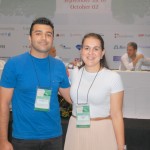 Oral: Photoelectrochemical Study Of Ta3N5 Nanotubes For Water Splitting; Sherdil Khan1, Marcos Jose Leite Santos1, Jairton Dupont1, Sérgio Ribeiro Teixeira1; 1Universidade Federal do Rio Grande do Sul.
Oral: Photoelectrochemical Study Of Ta3N5 Nanotubes For Water Splitting; Sherdil Khan1, Marcos Jose Leite Santos1, Jairton Dupont1, Sérgio Ribeiro Teixeira1; 1Universidade Federal do Rio Grande do Sul.
 Poster: Hydrogen Production From Rice Husk Gray Obtained In The Pyrolysis Process; Suelen Rodrigues Almeida1, Carolina Elicker1, Bruno Muller Vieira1, José Ramon Jurado Egea2, Pedro José Sanches Filho3, Mário Lúcio Moreira1, Sergio da Silva Cava1, Cristiane Raubach Ratmann1;1Universidade Federal de Pelotas, 2Consejo Superior de Investigaciones Científicas, 3Instituto Federal de Educação, Ciência e Tecnologia Sul.
Poster: Hydrogen Production From Rice Husk Gray Obtained In The Pyrolysis Process; Suelen Rodrigues Almeida1, Carolina Elicker1, Bruno Muller Vieira1, José Ramon Jurado Egea2, Pedro José Sanches Filho3, Mário Lúcio Moreira1, Sergio da Silva Cava1, Cristiane Raubach Ratmann1;1Universidade Federal de Pelotas, 2Consejo Superior de Investigaciones Científicas, 3Instituto Federal de Educação, Ciência e Tecnologia Sul.
– Simposium M winners
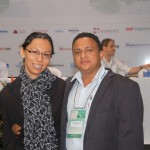 Oral: Graphene Nanoribbons Decorated With Magnetic Fe3O4 Nanoparticles For Dna Sensing; Blanca Azucena Gómez Rodríguez1, Manuel Perez Caro2, Deborah Zanforlin3, Ana Laura Elías4, José Luiz Lima1,5, Antonio Gomes Souza Filho6, Mauricio Terrones4, José Albino Aguiar1; 1Universidade Federal de Pernambuco, 2Texas State University, 3Universidade Federal de Pernanbuco, 4Penn State University, 5Departamento de Bioquímica – Ufpe, 6Universidade Federal do Ceará.
Oral: Graphene Nanoribbons Decorated With Magnetic Fe3O4 Nanoparticles For Dna Sensing; Blanca Azucena Gómez Rodríguez1, Manuel Perez Caro2, Deborah Zanforlin3, Ana Laura Elías4, José Luiz Lima1,5, Antonio Gomes Souza Filho6, Mauricio Terrones4, José Albino Aguiar1; 1Universidade Federal de Pernambuco, 2Texas State University, 3Universidade Federal de Pernanbuco, 4Penn State University, 5Departamento de Bioquímica – Ufpe, 6Universidade Federal do Ceará.
 Poster: Adjusting Supramolecular Electrostatic Interactions To Produce Mucoadhesive Nanocarriers For Protein Delivery; Leonardo Miziara Barboza Ferreira1, Natália Noronha Ferreira, Charlene Priscila Kiill, Jovan Duran Alonso, Maria Palmira Daflon Gremião; 1Faculdade de Ciências Farmacêuticas-Unesp.
Poster: Adjusting Supramolecular Electrostatic Interactions To Produce Mucoadhesive Nanocarriers For Protein Delivery; Leonardo Miziara Barboza Ferreira1, Natália Noronha Ferreira, Charlene Priscila Kiill, Jovan Duran Alonso, Maria Palmira Daflon Gremião; 1Faculdade de Ciências Farmacêuticas-Unesp.
– Simposium N winners
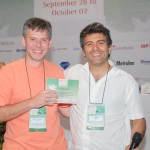 Poster: Preparation and Characterization Of The Lbl Films Based Nanoparticle Graphene Oxide Interacting With 3-N-Propylpirydinium Silsesquixane Chloride; Rodolfo Bonoto Estevam, Rodolfo Thiago Ferreira1, Alan Ben-Hur Bischof, Fábio Santana dos Santos, Cleverson Siqueira Santos, Sérgio Toshio Fujiwara, Karen Wohnrath, Jarem Garcia, Christiana Andrade Pessoa; 1Universidade Estadual de Ponta Grossa.
Poster: Preparation and Characterization Of The Lbl Films Based Nanoparticle Graphene Oxide Interacting With 3-N-Propylpirydinium Silsesquixane Chloride; Rodolfo Bonoto Estevam, Rodolfo Thiago Ferreira1, Alan Ben-Hur Bischof, Fábio Santana dos Santos, Cleverson Siqueira Santos, Sérgio Toshio Fujiwara, Karen Wohnrath, Jarem Garcia, Christiana Andrade Pessoa; 1Universidade Estadual de Ponta Grossa.
– Simposium O winners
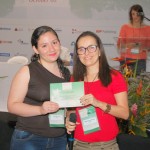 Poster: Layered Materials As Nanocarriers To Bioactive Molecules; Caroline Silva de Matos, Michele Aparecida Rocha1, Christine Taviot Gueho2, Fabrice Leroux2, Vera Regina Leopoldo Constantino1; 1Instituto de Química da Universidade de São Paulo, 2Institut de Chimie de Clermont-Ferrand.
Poster: Layered Materials As Nanocarriers To Bioactive Molecules; Caroline Silva de Matos, Michele Aparecida Rocha1, Christine Taviot Gueho2, Fabrice Leroux2, Vera Regina Leopoldo Constantino1; 1Instituto de Química da Universidade de São Paulo, 2Institut de Chimie de Clermont-Ferrand.
– Simposium P winners
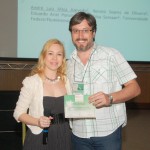 Poster: Sensor Development Exploiting Graphite-Epoxy Composite As Electrode Material. André Luiz Maia Azevedo1, Renato Soares de Oliveira1, Eduardo Ariel Ponzio1, Felipe Silva Semaan1; 1Universidade Federal Fluminense.
Poster: Sensor Development Exploiting Graphite-Epoxy Composite As Electrode Material. André Luiz Maia Azevedo1, Renato Soares de Oliveira1, Eduardo Ariel Ponzio1, Felipe Silva Semaan1; 1Universidade Federal Fluminense.
– Simposium S winners
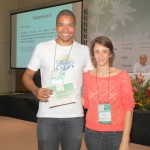 Poster: Structural, Thermal and Optical Studies Of A Nanostructured Composite Formed By Binary Mixtures Of Elemental Nickel and Antimony Powders Produced By Mechanical Alloying; Gleison Adriano da Silva1, Sérgio Michielon de Souza1; 1Universidade Federal do Amazonas.
Poster: Structural, Thermal and Optical Studies Of A Nanostructured Composite Formed By Binary Mixtures Of Elemental Nickel and Antimony Powders Produced By Mechanical Alloying; Gleison Adriano da Silva1, Sérgio Michielon de Souza1; 1Universidade Federal do Amazonas.
